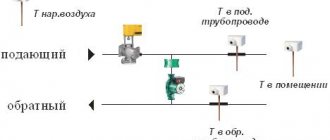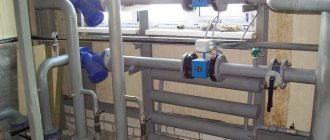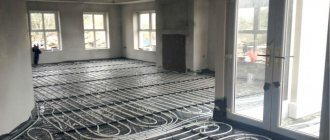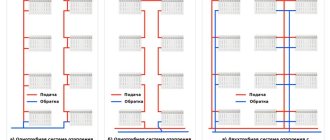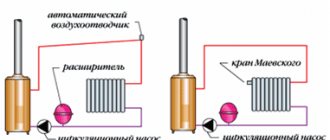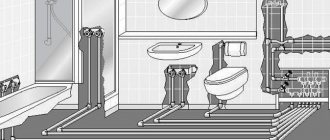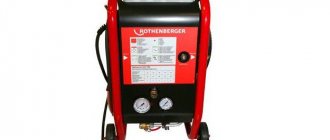Hot water supply and heating in apartment buildings have become an integral element of the necessary comfort. Calculations and construction are carried out in accordance with SNiP 2.04.01-85, which guarantees uninterrupted operation of properly designed systems over a long period of operation.
DHW and heat supply diagram
A hot water supply system (DHW) is a set of devices that provide heating of cold water and its distribution to water distribution devices.
There are two domestic hot water and heat supply systems for residential buildings:
- open;
- closed.
An open hot water system means that hot water is drawn from the heating system. Accordingly, for this, the coolant must be of good quality, suitable for domestic use and comply with sanitary standards. In terms of design, such a scheme is much simpler and its production requires much less material, but the volume of liquid must be constantly monitored to prevent airing of the heating system.
Thus, the main advantage of an open scheme is its lower cost compared to a closed one. The main disadvantage is the need to constantly monitor the volume of coolant.
In a closed system, the coolant and consumed water do not mix with each other. It delivers to consumers not the coolant, but its heat. The latter is transferred in a heat exchanger.
This is precisely the scheme that is preferred in modern housing construction, both private and multi-apartment. The disadvantage of such a system is its cost. Installation requires expensive equipment - a boiler, boiler, etc. The undeniable advantage of a closed hot water supply system is the complete independence of the consumer from central heating networks and the ability to individually adjust the water temperature.
Open and closed hot water supply systems are systems with different operating principles.
Main differences:
- Closed - designed so that cold drinking water taken from the main water supply is heated in the heat exchanger by the network coolant, and then supplied to the consumer.
- Open is a system in which heated water is taken from the supply and return heat pipelines into a mixer, where it is brought to a temperature of 65ºC, and then supplied to hot water taps for domestic use.
This is what the hot water supply system of an apartment building looks like, diagrams.
There are three types of hot water supply systems
Open - when the consumer uses water through taps from the general water supply system that is the same as the heating system, that is, the coolant itself.
Closed - when cold drinking water is heated in a special heat exchanger, that is, cold water and coolant do not come into contact with each other.
Independent - when cold water, after heating at a heating point, is supplied to the consumer through a separate pipeline system.
Multi-story houses
To meet the needs of residents of multi-storey buildings for hot water, special devices for heating water are built - heating points. This is a whole complex of parts and assemblies, power plants that provide heating, operating modes and distribution of water depending on the types of consumption.
Hot water in a multi-storey building is created either by an individual heating point - for one house, located in the basement or on the roof, or a central one - for several houses, located in a separate building.
Private houses
Hot water in a private home is, of course, convenience and comfort. To obtain warm water, you can use several methods, including a water heater.
When selecting a water heater, you need to take into account the workload of the hot water supply system and the number of screens for water selection. The choice of equipment is made taking into account the fuel used to operate the system. Gas is considered the most suitable for this.
Country houses
Hot water in a country house is the main condition for comfortable living.
Like all communications in a country house, the hot water supply system must be carefully designed.
Typically, a country house uses a combined water heating system, that is, a boiler and a boiler. Boilers are devices for indirect water heating. They differ in volume and power, which allows you to select the required water heater depending on the number of people living in the house, the number of water taps, the required amount of water for technological needs and the quick provision of hot water to residents.
Elements
A water metering unit is a piping unit of a water supply network consisting of shut-off valves, measuring instruments and fittings. The elevator unit is an element of the heating system that allows you to reduce the temperature of the coolant supplied from the thermal power plant to the set level.
The heating elevator mixes high-temperature coolant from the thermal power plant and cooled coolant from the return heating line of an apartment building.
Bottlings
Water supply bottlings are horizontal pipes that run through the basement and connect the risers to the elevator and water meter units. The filling diameter, depending on the material and volume of water consumers, ranges from 32 to 100 mm.
A water supply project for an apartment building must take into account not only the current condition of the pipelines, but also their inevitable overgrowth with sediment and rust after 20-25 years of operation. There are two dispensers in the hot water circulation system.
For internal hot water pipelines, SNiP 2.04.01-85 recommends the use of plastic pipes and fittings.
Fittings are used from:
- polyethylene;
- polypropylene;
- polyvinyl chloride;
- metal-polymer;
- fiberglass;
- other plastic materials for water supply networks.
To avoid corrosion, the systems are made of galvanized pipes.
For all internal water supply networks of an apartment building, you can use:
- copper pipes;
- shaped parts;
- bronze pipes;
- with a protective coating against rust;
- brass pipes.
With pipe diameters of more than 150 mm in open heat supply systems, black pipes can be used. Thermal insulation of these elements is mandatory for hidden wiring and in unheated rooms. You can use foamed polyethylene; it will make a so-called “fur coat”.
Types of open systems
The system can have two versions: centralized or decentralized. The difference is that the centralized system provides several consumers (from one building to an entire village). The decentralized system prepares water directly at the point of use, using small heating devices.
To supply hot water, one of two types of schemes can be used: with circulation pipelines, or a non-circulation scheme. The non-circulation hot water supply scheme is characterized by its structural simplicity and low starting cost.
Risers and liners
Risers are responsible for the vertical distribution of water in apartments located one above the other. The connections perform the function of distributing liquid through taps and other plumbing fixtures inside the apartment.
In apartments, serial (tee) wiring is traditionally used. The collector type is more material-intensive and requires hidden installation of connections, which greatly complicates their further maintenance.
DHW systems are divided into two types:
- centralized;
- local (decentralized).
In centralized systems, a heating installation in a central heating point (centralized heating point) can serve one or more buildings within a microdistrict or village. Centralized circuits are designed and installed with circulation pipelines for uninterrupted supply of hot water. Without them, in the absence of water supply in the supply pipelines, the water cools down, and the consumer is forced to drain it, which leads to excessive water consumption on the meter. In addition, heated towel rails are installed, which cannot work in the absence of circulation.
Decentralized (local) hot water supply is used in cases where the construction of a centralized scheme is not economically profitable: with a low density of heat loads in rural settlements, etc.
DHW schemes are:
- With a dead-end pipeline, where, with low consumption or no water withdrawal, the water quickly cools down. This scheme is used in low-rise residential buildings with a short network, bath and laundry plants.
- With circulation risers. Similar schemes are used in multi-storey residential buildings and hotel complexes.
What is special about the water supply of an apartment building?
It is very difficult to provide water to a building with a large number of storeys. After all, the house consists of many apartments with separate bathrooms and plumbing fixtures. In other words, water supply schemes in apartment buildings are a kind of complex with separate pipe distribution, pressure regulators, filters and metering equipment.
Most often, residents of high-rise buildings use water from the central water supply. With the help of a water supply, it is supplied to individual plumbing fixtures under a certain pressure. Often water is purified using chlorination.
Methods of obtaining and types of hot water supply
According to the method of production, DHW systems are divided into two types:
- open;
- closed.
Hot water supply for an apartment building comes in two versions:
- with single-pipe risers;
- with two-pipe risers.
The two-pipe system consists of two risers:
- server;
- circulation.
The heated water flows through the supply riser to the apartments, and through the circulation riser into the central main. Both pipelines are nearby. Heated towel rails are placed on the circulation riser in bathrooms - curved pipes that not only heat the rooms, but also compensate for temperature changes in the length of the pipe. The water in them will no longer be disassembled by consumers, but will be returned through the central pipeline back to the boiler room.
In a single-pipe scheme, each consumer has one riser - supply, and all circulation pipes are combined into one “idler”. It has no consumers, and the water through it returns to the main line.
Heated towel rails with this design:
- placed on the supply pipe;
- electric ones are installed;
- connect to the heating bed.
In the latter case, heated towel rails only operate during the heating season.
With any wiring scheme, the hot water supply system of an apartment building must be able to drain periodically occurring air pockets. With the top wiring, automatic relief valves are installed for such purposes; with the bottom, air can be removed through the top water intake valve.
Calculation and recycling
For an open hot water supply option, calculations are made in the following sequence:
- The drawing shows circulation rings that are closed at the thermal unit. In a water heating installation of this type, supply and circulation pipelines are separated.
- On the circuit that has the maximum extent, areas with constant circulation flow are marked.
- The diameter of the circulation pipes is determined, which cannot be less than 15 mm. Also, when carrying out calculations, it is necessary to maintain the ratio of the diameters of the supply and circulation sections. To ensure a uniform flow of liquid and minimize the formation of air pockets, the circulation section of the water supply system is made of pipes, the diameter of which should be 1 to 2 sizes larger than when installing the supply section of the water supply system.
Considering the significant difficulty in independently calculating the diameters of pipelines, if the flow rate of liquid heated to a certain temperature is low, it is recommended to install a valve on the circulation riser. Thanks to this element, it will be possible to experimentally adjust the throughput of the circuit, which will allow achieving a minimum difference in pressure between the supply and circulation parts of the open DHW circuit.
Wiring in the apartment
There are two main schemes for distributing water supply in an apartment:
- tee (sequential);
- collector
Both schemes have their advantages and disadvantages. Sometimes it makes sense to use a combination of these schemes.
The sequential scheme is the traditional way of designing and installing water supply in an apartment. This circuit consists of one common pipe to which all devices are connected in series. Tees are used to connect plumbing fixtures, which is why this scheme is called a tee. The main pipe must be larger in diameter than the others, as it takes on the functions of a collector.
One of its significant advantages is the smaller number of pipes compared to the collector circuit. Therefore, the costs of its installation will be minimal.
The collector wiring diagram is the optimal choice for large apartments, as well as in places where the installation of a large number of plumbing fixtures is required. Water from the common riser enters the collector and is then sent to consumers, that is, to appliances.
Each consumer is connected separately. One of the main advantages of the collector circuit is the uniform distribution of water. This means that the number of connected devices and the length of water pipes do not reduce the pressure for any of the consumers.
The video demonstrates the cold and hot water input unit in an apartment in a multi-storey building.
Malfunctions
Main malfunctions of the water supply system valve:
- when closed, it allows water to pass through;
- liquid flows through the rod;
- presence of leakage through threaded connections.
The causes of malfunctions are wear of the rubber valve gasket, seat shell, worn rod threads, worn out stuffing box, weak seal of threaded connections.
If a mixer with a ceramic axle box begins to make noise, then the cause is a sagging silicone washer. It is best to replace the ceramic valve axle with the same new one or an analogue.
Lever mixers make virtually no noise, but if this does happen, the only solution is to normalize the pressure in the system. To do this, reducers are installed in front of the mixer, which limit the pressure, then the noise stops. A similar approach can be used to eliminate noise in a hygienic shower mixer.
The video shows how to correctly calculate the cost of hot water.
DHW system of a private house
Household water heating devices are:
- electrical;
- gas;
- solid fuel;
- indirect heating.
Based on the method of heating the liquid, water heaters are divided into two types:
- Flow-through, in which heating occurs as water moves past heat-transmitting elements.
- Cumulative, where heating is carried out in special containers of the device using heat transfer elements.
In a private house, as a rule, a collector water supply system is designed and installed.
The choice of design and installation of apartment building systems, as a rule, depends on the conditions for implementing SNiP 2.04.01-85 and the capabilities of the customer.
